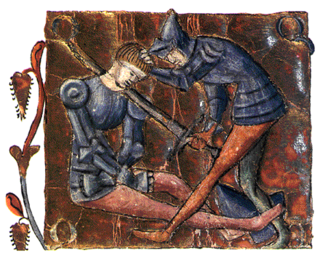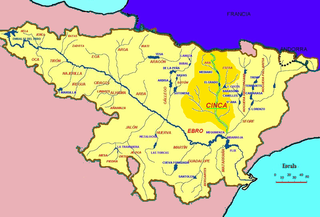 W
WThe Battle of Alcoraz took place in 1096 outside Huesca, pitting the besieging forces of Peter I of Aragon and Navarre against the relief forces of Al-Musta'in II of Zaragoza.
 W
WThe Battle of Araviana was a cavalry action fought during the War of the Two Peters on 22 September 1359. Eight hundred Aragonese horse, many of them Castilian exiles in service of the Crown of Aragon under Henry of Trastámara, had launched a cavalgada in Castilian territory when, near the Castilian town of Ágreda, confronted and routed a Castilian force under Juan Fernández de Henestrosa set to guard the frontier. Numerous Castilian noblemen and knights were killed, including Henestrosa, while many other were captured.
 W
WThe Battle of Bairén was fought between the forces of Rodrigo Díaz de Vivar, also known as "El Cid", in coalition with Peter I of Aragon, against the forces of the Almoravid dynasty, under the command of Muhammad ibn Tasufin. The battle was part of the long Reconquista of Spain, and resulted in a victory for the forces of the Kingdom of Aragon and the Kingdom of Valencia.
 W
WThe Battle of Morella, southwest of Tortosa, was fought between Sancho Ramírez, King of Aragon and Navarre, and Yusuf al-Mu'tamin, King of Zaragoza, while the former was engaged in a campaign of conquest against the latter. All surviving sources for the battle are either later by a generation or literary in character, and they are confused on the chronology and dating of the event. The encounter was a defeat for Sancho and sparked a brief reversal of fortunes in the Navarro-Aragonese Reconquista. The Castilian hero, Rodrigo Díaz de Vivar, El Cid, was a general for al-Mu'tamin at the time. According to the Aragonese Crónica de San Juan de la Peña (c.1370), Sancho later sought out El Cid, who had also defeated his father in the Battle of Graus (1063), and defeated him in the year 1088. However, the Crónica is the only source mentioning such an encounter and, as it was written three hundred years later, most leading scholars give no credence to this claim, which was probably intended to justify the prerogatives of Peter IV of the Crown of Aragon.
 W
WThe Battle of the Col de Panissars was fought on 30 September and 1 October 1285 between the forces of Philip III of France and Peter III of Aragon. It was a severe defeat for the French, who were already retiring over the Pyrenees when the Aragonese fell on them.
 W
WThe Battle of Cutanda or Batalla de Cutanda was a battle in June of the year 1120 between the forces of Alfonso I the Battler and an army led by Ibrahim ibn Yusuf occurring in a place called Cutanda, near Calamocha (Teruel), in which the Almoravid army was defeated by the combined forces, mainly of Aragon and Navarre.
 W
WThe Battle of Fraga was a battle of the Spanish Reconquista that took place on 17 July 1134 at Fraga, Aragon, Spain. The battle was fought between the forces of the Kingdom of Aragon, commanded by Alfonso the Battler and a variety of Almoravid forces that had come to the aid of the town of Fraga which was being besieged by King Alfonso I. The battle resulted in an Almoravid victory. The Aragonese monarch Alfonso I died shortly after the battle.
 W
WThe Battle of Las Navas de Tolosa, known in Arab history as the Battle of Al-Uqab, took place on 16 July 1212 and was an important turning point in the Reconquista and in the medieval history of Spain. The Christian forces of King Alfonso VIII of Castile were joined by the armies of his rivals, Sancho VII of Navarre and Peter II of Aragon, in battle against the Almohad Muslim rulers of the southern half of the Iberian Peninsula. The caliph al-Nasir led the Almohad army, made up of people from all over the Almohad Caliphate.
 W
WThe Battle of Llucmajor occurred in 1349 when Peter IV of Aragon's forces defeated and killed his cousin James III of Majorca in the town of Llucmajor on the Balearic Islands, resulting in the end of the independent Kingdom of Majorca.
 W
WThe battle of Morvedre (1412) was an armed confrontation between supporters of Ferdinand of Antequera and James II of Urgell that occurred in the Kingdom of Valencia during the interregnum in the Crown of Aragon after the death of Martin I.
 W
WThe Battle of Muret, fought on 12 September 1213 near Muret, 25 km south of Toulouse, was the last major battle of the Albigensian Crusade and one of the most notable pitched battles of the Middle Ages. Although estimates vary considerably, even among distinguished modern historians, it is famed for having pitted a measly force of French knights and crusaders commanded by Simon de Montfort the Elder against a vastly superior allied army led by King Peter II of Aragon and Count Raymond VI of Toulouse.
 W
WOn 25 December 1084, at the Battle of Piedra Pisada, the Taifa of Zaragoza fought and probably defeated the Kingdom of Aragon on the road south from Naval to El Grado. The battle was a minor engagement of the ongoing Reconquista of Aragon, the process by which the riverine valleys of the southern slopes of the Pyrenees were gradually conquered and returned, after centuries of Muslim rule, to the control of Christian princes. The ruler of Aragon, who personally led his men in battle at Piedra Pisada, Sancho Ramírez, also ruled Kingdom of Navarre and was a major figure in the contemporary Reconquista.
 W
WThe naval battle of Ponza was fought in early August 1435, when the Duke of Milan dispatched the Genoese navy to relieve the besieged town of Gaeta, which was currently under threat from the King of Aragon.